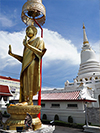|
Wat Phitchaya Yahtikarahm Worawihaan (วัดพิชยญาติการามวรวิหาร)
Thai. Name of an ancient Buddhist
temple in
Bangkok's
Thonburi
district,
that at some was abandoned, until it in 1829 AD was renovated by
Somdet
Chao Phraya
Borom
Maha
Phichaiyaht,
who is also known as
Tat Bunnag
and whose statue today stands at the temple's front entrance (fig.),
adjacent to a
Buddha image
in
the
pahng hahm samut
pose, i.e.
standing while
performing an
abhaya-mudra
with both hands raised.
After its restoration,
which was finalized in 1832 AD, King
Rama III (fig.)
named the temple Wat
Phraya
Yahtikarahm (วัดพระยาญาติการาม),
in honour of Tat. It is a
compound name that points to the
bandasak
of Tat, then a
Phraya,
and the fact that the Bunnag family through marriage had become relatives
to the royal family, i.e. yaht (ญาติ), which in Thai is
spelled with a silent vowel
‘i’
at the end, which is only pronounced in compound words,
whereas
araam
is another term for ‘temple’, whilst the ‘k’ is used as a linking
element or interfix. King
Rama IV
later renamed the temple Phitchaya Yahtikarahm making its connection
to Tat more personal, while he
declared it
a second class
royal monastery, adding the titles
wora
and
viharn,
i.e. a compound appendix usually transliterated
Worawihaan,
and meaning ‘royal chapel’.
The temple is in Thai-Chinese style and the roof of the
ubosot,
i.e.
the main prayer hall, lacks the usual
chofa
(fig.)
and
bai raka (fig.),
typical on most Thai Buddhist temple roofs
elsewhere. Instead, the ubosot's
gable board
is decorated with
porcelain
figures of
Chinese dragons,
phoenixes,
and a
puranakata
or
Treasure Vase.
The ubosot's principal
Buddha image
is seated
in
the
maravijaya
pose and is
known as
Phra
Sittharot,
i.e. ‘Siddhartha
Buddha’,
as well as by the name
Luang Pho
Somprathana (หลวงพ่อสมปรารถนา), which translates as the ‘Revered
Father who Fulfills
One's Wish’. In front of
the ubosot are some stone sculptured figures from
China,
i.e. granite statues
of
Imperial Guardian Lions
(fig.)
and
Chinese door gods,
that are said to have been
brought to
Siam
as ballast to weigh down the
otherwise empty ships.
In
front of the ubosot,
to
the right of the entrance is a
golden statue of
Thoranee (fig.),
and to the left is a
gilded
statue of
Phra Sangkatjaai. In
between the temple's
front entrance and the ubosot are two
stupas built
in Singhalese style and known as
Chedi
Koo (เจดีย์คู่),
i.e. the ‘Twin
Pagodas’, which each are 11
wah
(ca. 22 meter) tall and have a square base with a circumference of
23
wah
(ca. 46 meter), and are described as miniature versions of the
Phra Borommathat Chedi of
Nakhon Sri Thammarat
(fig.).
One stupa houses a silver Buddha image
known as Luang Pho Ngeun (หลวงพ่อเงิน
-
fig.),
the other a golden called
Luang Pho Thong (หลวงพ่อทอง
-
fig.)
and both decorated, one with silver, the other with golden flowers,
reminiscent of
ton mai ngeun ton mai thong
(fig.). On the right and left sides of the
ubosot, along the temple's surrounding walls, are small rock gardens
fashioned in the style of
Chinese rockery
and used to enshrine ashes of deceased local citizens. In the back
of the compound is a large white
prang that
incorporates a traditional Thai-style
multiple
temple roof with
bird's head-like finials called
chofa, and
topped with a golden
noppasoon,
i.e. the decorative spire on the
apex of the prang. The main tower is surrounded by four smaller
prangs and on each of the
four sides of the
main prang is a
niche
that contains a standing Buddha image. The
circumference of the base of the
prang is 33
wah
and 2
sok
(ca. 67.22 meter), while its height measured from the bottom to the
top of the spire is 21
wah,
1
sok,
and 10
niw
(ca. 42.82 meter).
See also
TRAVEL PICTURES (1),
(2),
(3),
(4),
(5),
(6),
(7),
(8),
(9),
(10),
(11),
(12)
and
(13),
and
MAP.
回






|

